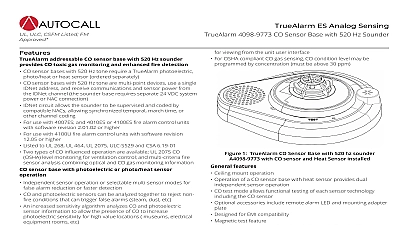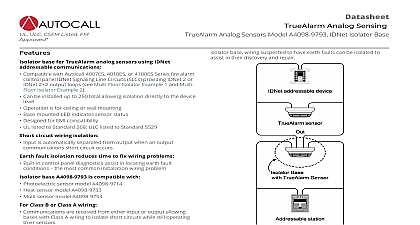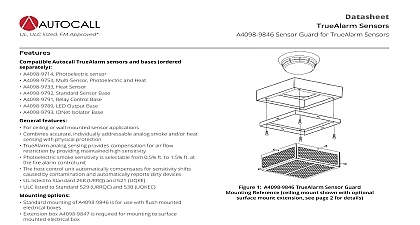Autocall TrueAlarm A4098-9772 Sensor Base with 520 Hz Sounder

File Preview
Click below to download for free
Click below to download for free
File Data
| Name | autocall-truealarm-a4098-9772-sensor-base-with-520-hz-sounder-6573894201.pdf |
|---|---|
| Type | |
| Size | 1.55 MB |
| Downloads |
Text Preview
UL ULC CSFM Listed FM addressable sensor base with 520 Hz sounder TrueAlarm sensor bases with 520 Hz tone require a TrueAlarm photo heat or heat sensor ordered separately TrueAlarm sensor bases with 520 Hz tone are multi point devices use single IDNet address and receive communications and sensor power the IDNet channel the sounder base requires separate 24 VDC power or NAC connection IDNet circuit allows the sounder to be supervised and coded by NACs allowing synchronized temporal march time or channel coding Sensor and sounder operation is listed to UL Standard 268 UL 464 and ULC Standard S529 Sounder operation is also listed to UL Standard 464 as an audible appliance base with photoelectric or photo heat sensor operation Independent sensor operation or selectable multi sensor modes for alarm reduction or faster detection Photoelectric photo heat or heat sensors can be analyzed to reject conditions that can trigger false alarms steam dust etc Hz Sounder base operation Low Frequency sound output 520 Hz at 85 dBA The base can supervise the sounder drive circuit when an AUX 24V line is used for sounder power Alternatively base supervision be disabled if a supervised NAC is needed to power the sounder coded outputs Sounder can be manually activated from the control unit 520 Hz Sounder bases are listed for Special Application when used a compatible NAC circuit unit operation summary sensor information is digitally transmitted to the host control unit IDNet communicationsfor processing to evaluate and track status features Ceiling mount operation Optional accessories include remote alarm LED and mounting adapter Designed for EMI compatibility Magnetic test feature Hz Sounder base features mounted address selection allows the address to remain with programmed location when the sensor is removed for service or type sensor type identification provides default sensitivity substituting sensor types Different sensor types can be easily to meet specific location requirements This feature also intentional sensor substitution during building construction of covering the smoke sensors when conditions are temporarily heat sensors may be installed without reprogramming the control red LED indicates power on by pulsing or alarm or trouble steady on The exact status is annunciated at the fire alarm control ES Analog Sensing A4098 9772 Sensor Base with 520 Hz Sounder 1 sensor base with 520 hz A4098 9772 with heat sensor installed reference sensor locations after careful consideration of the physical and contents of the area to be protected fire alarm applications Refer to NFPA 72 the National Fire Alarm and Signaling Code On smooth ceilings smoke sensor spacing of 30 ft 9.1 m may be used a guide detailed application information to A4098 Detectors Sensors and Bases Application Manual Part 574 709AC unit operations sensor features include sensitivity monitoring satisfying 72 sensitivity testing requirements automatic individual sensor checking to verify sensor integrity automatic environmental available multi stage alarm operation display of directly in percent per foot monitoring of peak activity per alarm set point and time of day or multi stage alarm selection Alarm and Trouble LED Indications sensor base LED pulses to indicate communications with the control If a sensor is in alarm or has a trouble condition the status is at the control unit and that base LED will turn on steady a system alarm the control unit will control LEDs such that a indication will return to pulsing to help identify the sensors in Allocation 4007ES 4010ES and 4100ES control units only one 1 point at the host unit for each sensor base on sensor base and sensor choice up to seven 7 points can made public to a connected Autocall Fire Alarm Network Each sensor uses a single address with sub points layered underneath such 1 1 0 1 1 1 1 1 2 4100U control units the requirement is three 3 points at the host for each sensor base with the A4098 9754 multi sensor and two 2 for the other sensors base with 520 Hz power requirements Power for the sensor is provided by IDNet communications No additional wiring is for upgrading of existing installed TrueAlarm sensor bases sounder bases do require system supplied separate VDC or wiring the same as the standard sounder base This product has been approved by the California State Fire Marshal CSFM pursuant to Section 13144.1 of the California Health and Safety Code See CSFM Listings 7300 0026 0315 7300 2269 0560 7272 2269 0537 5278 2269 0571 7270 2269 0512 and 7300 2269 0551 for allowable values and or conditions concerning material presented in this document listings may be applicable contact your local product supplier for the latest status Rev 5 11 2020 A4098 9772 Sensor Base with 520 Hz Sounder 3 on sensor base analysis correlates thermal activity and smoke at a single multi sensor location using an extensively tested relationship As a result TrueSense detection improves to conditions indicative of faster acting hot flaming fires when to the response of either photoelectric smoke activity or activity alone Heat sensor heat sensors are self restoring and provide rate fixed temperature sensing selectable with or without temperature sensing Due to its small thermal mass the accurately and quickly measures the local temperature for at the fire alarm control unit temperature detection is selectable at the control unit either 15 8.3 or 20 11.1 per minute Fixed temperature is independent of rate of rise sensing and programmable to at 135 57.2 or 155 68 In a slow developing fire the may not increase rapidly enough to operate the rate of feature However an alarm will be initiated when the temperature its rated fixed temperature setting heat sensors can be programmed as a utility device to for temperature extremes in the range from 32 to 155 to 68 This feature can provide freeze warnings or alert to HVAC problems 4 Heat sensor on sensor base In most fires hazardous levels of smoke and toxic gas build up before a heat detection device would initiate an alarm In where Life Safety is a factor the use of smoke detection is highly Remote red LED Alarm Indicator mounts on a single box to provide status indications where the sensor location may be readily visible analog sensor features against rear air flow entry Electronics are EMI RFI Heat sensing rate compensated fixed temperature sensing with or without operation Temp F 57.2 C 60 ft x 60 ft ULC 1 Rated spacing distance between sensors Spacing Either Fixed Setting ft x 20 ft 6.1 m for fixed only RTI Quick ft x 50 ft 15.2 m for fixed with either rate of rise RTI Ultra Fast ft x 40 ft m m F 68 C Sensors Photoelectric technology sensing 360 smoke entry for optimum response Built in insect screens Photoelectric sensor photoelectric sensors use a stable pulsed infrared LED source and a silicon photodiode receiver to provide consistent accurate low power smoke sensing Seven levels of sensitivity are for each individual sensor ranging from 0.2 to 3.7 per of smoke obscuration Sensitivities of 0.2 0.5 and 1 are for applications in clean areas Standard sensitivities are 1.5 2.0 3.0 and 3.7 Application type and sensitivity are selected and monitored at the fire alarm control unit For detailed application about sensitivity selection refer to Installation Instructions sensor head design provides 360 smoke entry for optimum smoke Due to its photoelectric operation air velocity is not normally factor except for impact on area smoke flow 2 Photoelectric Sensor on sensor base Multi Sensor multi sensors combine the performance of TrueAlarm smoke sensing with TrueAlarm thermal sensing to provide features in a single assembly Each sensing element provides data evaluation at the fire alarm control unit where the follow


